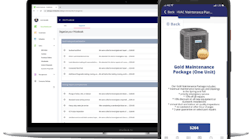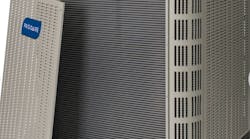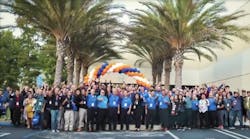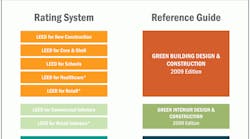At the 2009 AHR Expo, the HARDI Sustainable Building Committee held its first meeting since its initial scoping meeting at the 2008 Fall Conference. There the committee agreed that the new version of the Leadership in Energy and Environmental Design® (LEED®) offers significant opportunities for HVACR distributors. However, for HARDI members to take full advantage of the LEED movement, the most prominent green building certification required a narrowing and summarization for the HVACR industry. Sustainable Building Committee member Mark Smith of Ductmate Industries agreed to review the new LEED certification when it was released and isolate the most important elements for HARDI members. This article features Mr. Smith's analysis and summary of the key portions of LEED v3 drafted exclusively for HARDI distributor members.
— Talbot Gee, vice president, HARDI
It doesn't matter if you are a Fortune 500 company, a corner drugstore or a dedicated HVACR wholesaler; if you are not constantly improving your business, you are slowly getting worse. This statement is also relevant if you are a nonprofit organization such as the U.S. Green Building Council. The council, better known as the USGBC, continuously evaluates its green building certification programs to stay ahead of the competition and push for improvement over existing codes or standards.
On April 27, the USGBC launched LEED 2009, which includes LEED v3. LEED v3 represents a major evolution in the rating system, accreditation process and online certification services. The changes can appear overwhelming at first. However, you will find it easier to digest after breaking them down into the categories of the rating system, accreditation process and online services.
The primary objective behind the launch of LEED v3 is to incorporate new technologies and advances in building sciences. The new rating system consolidates most of LEED's existing nine separate rating systems into only three. These are Green Building Design and Construction, Green Interior Design and Construction, and Green Building Operation and Maintenance. USGBC left LEED for Homes and LEED for Neighborhood developments separate because of its recent introduction into the market in 2008. This article will focus on the Green Building Design and Construction rating system which is a consolidation of:
- LEED for New Construction (LEED NC)
- LEED for Core & Shell (LEED CS)
- LEED for Schools
- LEED for Healthcare
- LEED for Retail
The new format combines all of the credits from the previous five manuals into a library of credits contained in just one manual for Green Building Design and Construction. LEED v3 has also added regional priority credits, which incentivizes projects to take advantage of credits of special interest to the specific geographic area. The restructuring of its credit system increased the number of available points from 69 to 110, thus requiring a new scale for certification of LEED projects and reweighting of the point system. The new scale for project certification is as follows:
- 40-49 Certified
- 50-59 Silver
- 60-79 Gold
- 80-110 Platinum
Page 2 of 3
For those individuals familiar with the existing LEED systems, you will see a very familiar look and feel in the new system. LEED v3 contains all of the credits and prerequisites that appeared in the previous LEED NC system, as well as changing a credit to a prerequisite under the category of Water Efficiency.
Although the progression from LEED v2.2 to LEED v3 did not result in an elimination of credits, there is an expectation that this may change as the system continues to evolve. The USGBC is utilizing a new system to review and assign points to credits within the rating systems. The LEED v3 weighting system is the first step in a new process designed to incorporate the existing LEED structure with a more analytical evaluation of credits and their effect on building performance. The goal of the USGBC is to make future upgrades to the credit system more predictable.
The purpose of reweighting credits was to align them with their ability to either mitigate the building's negative environmental impact or promote the building's ability to have a positive impact on its environment. The system used to redistribute the credit points does not provide a quantitative value for each credit; instead, it provides a means for evaluating the credit's influence on other credits and its ability to affect the overall LEED score for the building. The system utilizes the EPA's TRACI environmental impact categories to determine which environmental impacts the LEED credits should focus upon. More information is available about EPA's TRACI categories at www.epa.gov/nrmrl/std/sab/traci/.
The TRACI system places a significant emphasis on carbon reductions and, thus, energy savings. As a result, LEED v3 places a stronger emphasis on requirements and credits affecting HVACR performance. LEED v2.2 had required buildings to meet ASHRAE standards 90.1-2004. LEED v3 requires the building to either utilize computer modeling to show it exceeds ASHRAE 90.1-2007 by a minimum of 10 percent or build it to comply with either the ASHRAE Advanced Energy Design Guides or comply with the prescriptive path of Advanced Buildings™ Core Performance™ Guide. The new rating system also increases the number of points available under EA Credit 1. EA Credit 1 provides the building designers with three options for achieving points. The first allows buildings to obtain one point by utilizing computer modeling to show it exceeds ASHRAE 90.1-2007 by a minimum of 12 percent and as many as 19 points by exceeding the standard by 48 percent. The second option requires designing the project to meet the appropriate ASHRAE Advanced Energy Design Guide. The third option is to design the building to meet the Advanced Buildings™ Core Performance™ Guide. Only one point can be earned for this credit under option two, and up to three points can be earned under option three.
LEED v3 also places higher requirements and incentives on water conservation. The new standard requires buildings to achieve a water reduction of 20 percent over the LEED-defined building model for measured improvements. The baseline commercial building model incorporates 1.6 gallons per flush (gpf) toilets, 1 gpf urinals and 2.2 gallons per minute (gpm) bathroom faucets. The new rating system also increases the minimum requirements to receive credits under Water Efficiency Credit 3. To receive a point under WE Credit 3, buildings must now reduce their water usage by a minimum of 30 percent over the LEED- defined building model.
Page 3 of 3
Many of the changes under LEED v3 were simply updates to codes which had a reference throughout credits and requirements. Previous versions of LEED rating systems referenced ASHRAE standards 90.1-2004 and 62.1-2004. The new rating systems reference ASHRAE standards 90.1-2007 and 62.1-2007.
The addition of regional priority credits is completely new and a welcome change for most buildings trying to achieve LEED certification. For those individuals familiar with the previous LEED rating systems, the regional priority credit section under LEED v3 follows a similar format as the innovation and design section utilized in the previous and current LEED rating systems. The regional priority credits identify existing LEED credits which are of specific interest to the geographic area of the building under construction. They then provide one additional point per credit for those buildings that choose to meet the credits specific to that region. Buildings are effectively receiving two points for the performance of a single credit. ZIP codes define regional priority credits and consist of six credit options per ZIP code. A project can choose to pursue up to four of the six available credit options.
For individuals who have a project that is currently pursuing or considering a LEED certification, there are a few important dates to remember. Projects registered between April 27, 2009, and June 26, 2009, can register under either LEED v2.2 or LEED v3. Projects currently registered under LEED v2.2 can upgrade for free to LEED v3 until Dec. 31, 2009. Projects registered after June 26 will be part of the v3 program.
All future project certification will now go through the Green Building Certification Institute (GBCI). The USGBC developed the GBCI in 2008 to handle both the certification of buildings under the LEED rating systems as well as the LEED accreditation process for those individuals pursuing professional accreditation. GBCI will follow ISO standards analysis and auditing to provide the LEED rating system with third-party verification.
LEED 2009 brought with it major changes to the LEED accreditation process. More than 85,000 professionals have become accredited professionals under the current program by completing an 80-question test administered by USGBC-approved testing facilities. Any individual who passed the exam became a LEED AP (Accredited Professional). The LEED AP status did not distinguish whether an individual had taken the exam for New Construction, Interior Design or Existing Buildings, nor did the LEED AP label provide any information on the individual's experience working with or administering a LEED certification process.
GBCI goals for the new certification process were to provide relevance, differentiation and specialization to the new accreditations. The new accreditation process takes aim to instill some of these qualities by developing multiple accreditation with tiered requirements and the ability to specialize within the specific rating system. GBCI's new LEED Green Associate program provides professionals with a way to show they have a general understanding of the LEED rating systems and green building concepts. The intent of the Green Associate program is to meet the needs of a broad audience of professionals. These professionals may not be a part of the building's design team but rather support the LEED process through other contributions. Green Associates could include lawyers, teachers, realtors, product manufacturers, wholesalers or anyone else involved in sustainable building. Interested professionals may begin taking the two-hour Green Associates exam starting May 18. To maintain accreditation as a LEED Green Associate, professionals will need to achieve 15 continuing education credits every two years. Credits are obtainable by a variety of activities. These activities may include attending events such as GreenBuild, the USGBC's main educational conference, attending approved green building courses taking place in your local market, participating in a registered LEED project or even participating in your local green building organization.
GBCI will transition the focus of the LEED AP program to represent those individuals who have an advanced understanding of green building design and construction. LEED AP status will focus on individuals who will be leading the design and construction of LEED- certified buildings. Individuals who acquire LEED AP status will be required to specialize in one of the LEED rating systems and will receive a designation which indicates his or her specialization. Like the Green Associates program, LEED AP accreditation requires professionals to maintain their accreditation by participating in LEED projects, educational events and other green building events or activities. LEED APs, however, must earn 30 credits every two years. Unlike the Green Associates program, LEED APs must first show they have experience working on a LEED-registered or -certified project before they may take the LEED AP exam.
The highest level of LEED accreditation is still in the research and development phase at the GBCI. We currently refer to the future accreditation as a LEED AP Fellow and will represent an individual with the highest level of green building knowledge. The title of LEED AP Fellow will most likely be ordained by the USGBC, and GBCI will most likely formalize the LEED AP Fellow title and will award it to people who have contributed significantly to the development of green building techniques.
Demand for green buildings also placed a tremendous burden on the USGBC systems that projects utilized to certify their buildings. GBCI has worked closely with the USGBC to improve and redeploy the LEED Online service. The new, more-robust service will provide LEED professionals with improved efficiency and a more user-friendly interface. The GBCI website will provide more-detailed information regarding the improvements to LEED Online in the coming months.
So what does all this mean to the HVACR wholesaler? LEED and green building have not withered on the vine as a result of lower energy costs or become victims of the current recession, as some had predicted. LEED is here to stay and has become the benchmark in building for everyone from Fortune 500 companies to hospitals and educational facilities. In the future, a building supplier who wants the reputation of being knowledgeable will need better understanding of the LEED rating system. Wholesalers should consider the cost and benefits of having a few of their employees participate in the LEED Green Associate accreditation or even pursue LEED AP status. They should also review the products they supply and how they can contribute to a project's ability to meet LEED certification or even consider expanding their product offering to include products which may grow in demand as a result of the popularity of LEED. Lastly, it is important to understand what paperwork will need to be supplied to support the LEED certification process as well as when it will be needed. Anyone who acquires a better understanding of LEED through the new GBCI accreditation process will easily understand this new information.
Mark Smith drives strategic development for DMI Companies as the business development manager. He has worked closely with contractors and engineers in the commercial and residential HVACR markets for more than 11 years while spearheading the company's marketing efforts. While employed at DMI, Mark has been successful at incorporating green building strategies within the business, having earned DMI the honor of being named the Manufacturer of the Year for the Sustainability category in Pittsburgh. His efforts in developing new products to target the green building market have also helped DMI to receive public funding for product development. Contact him at 724/258-0500 or [email protected].








